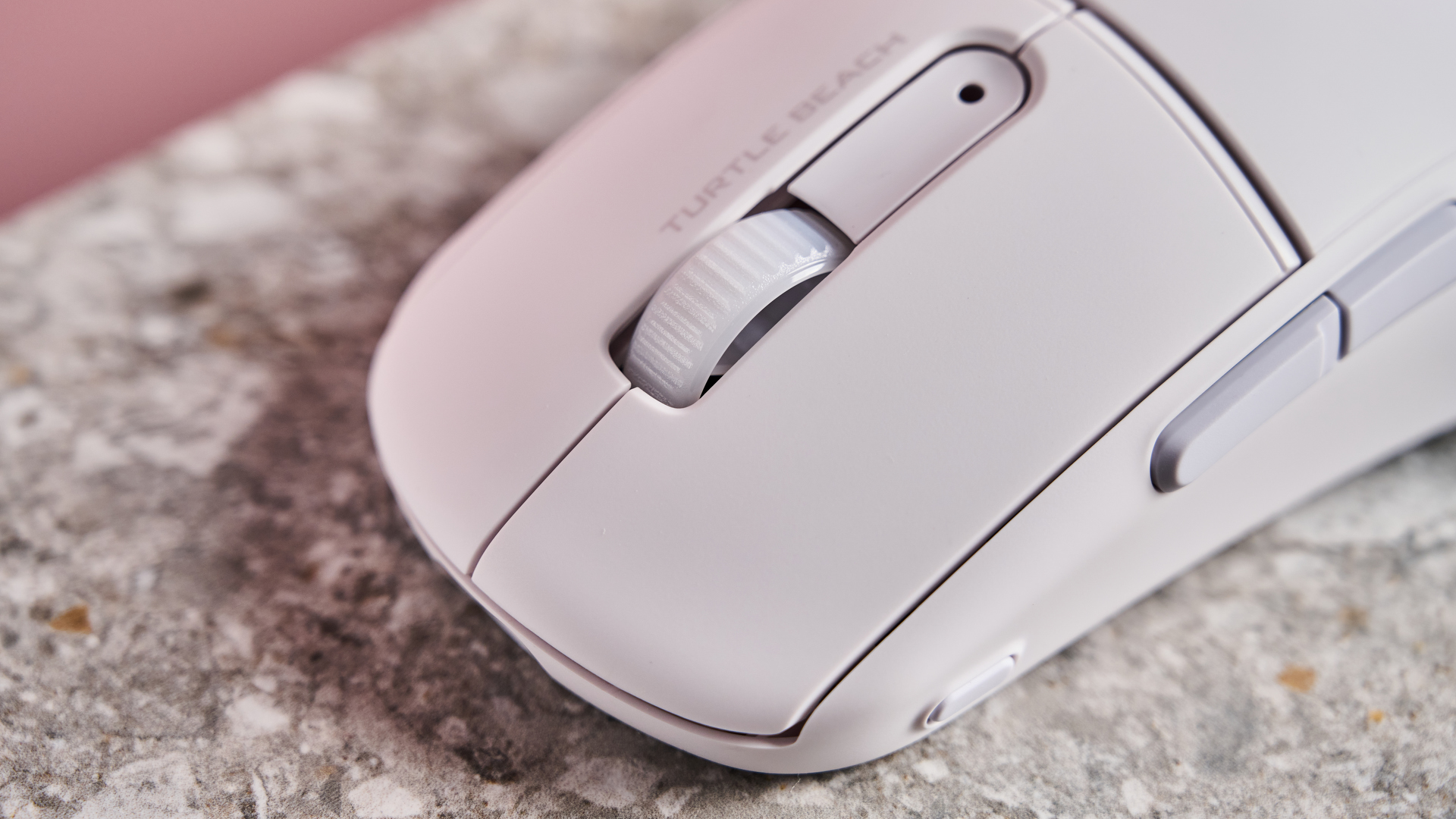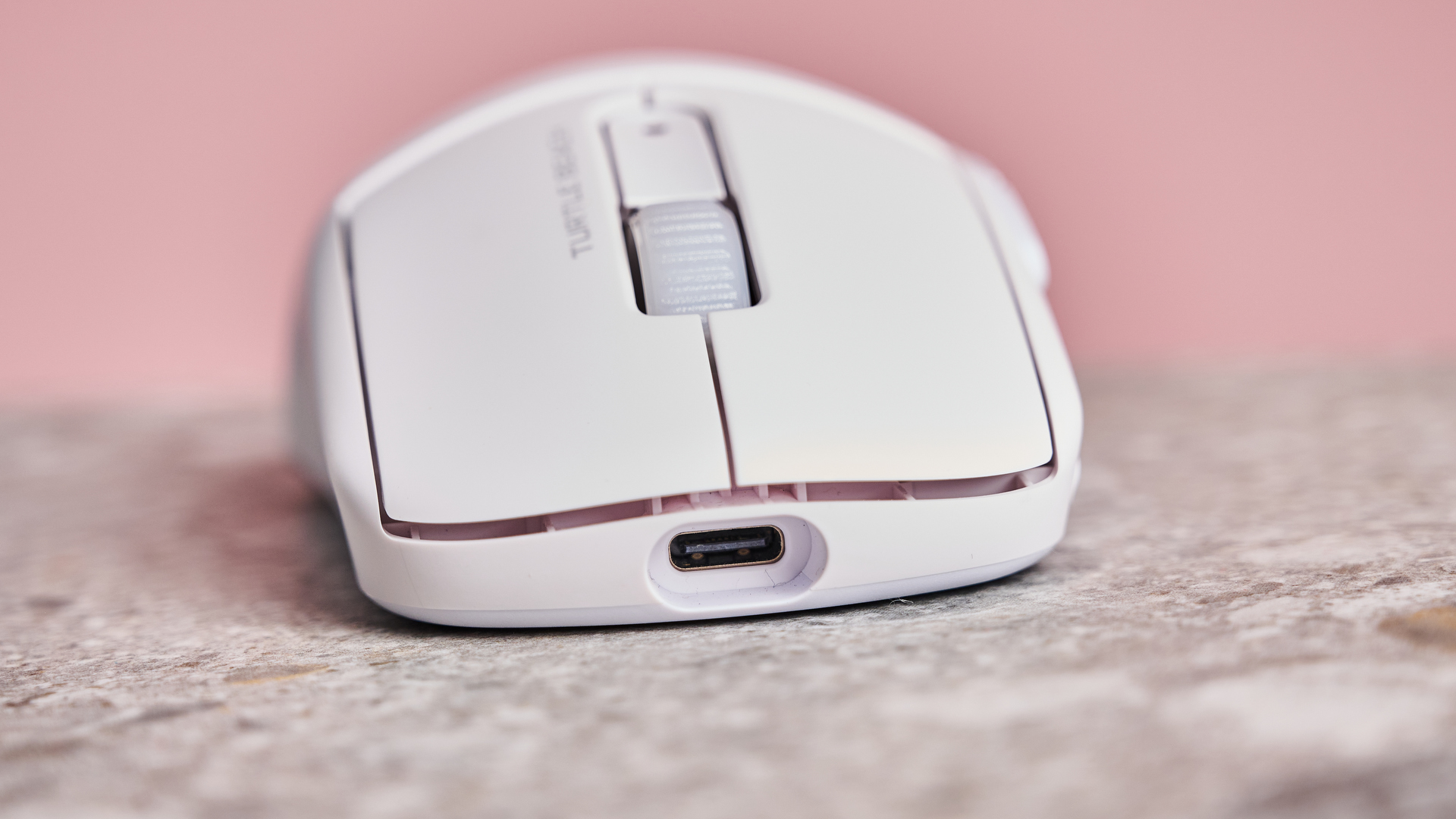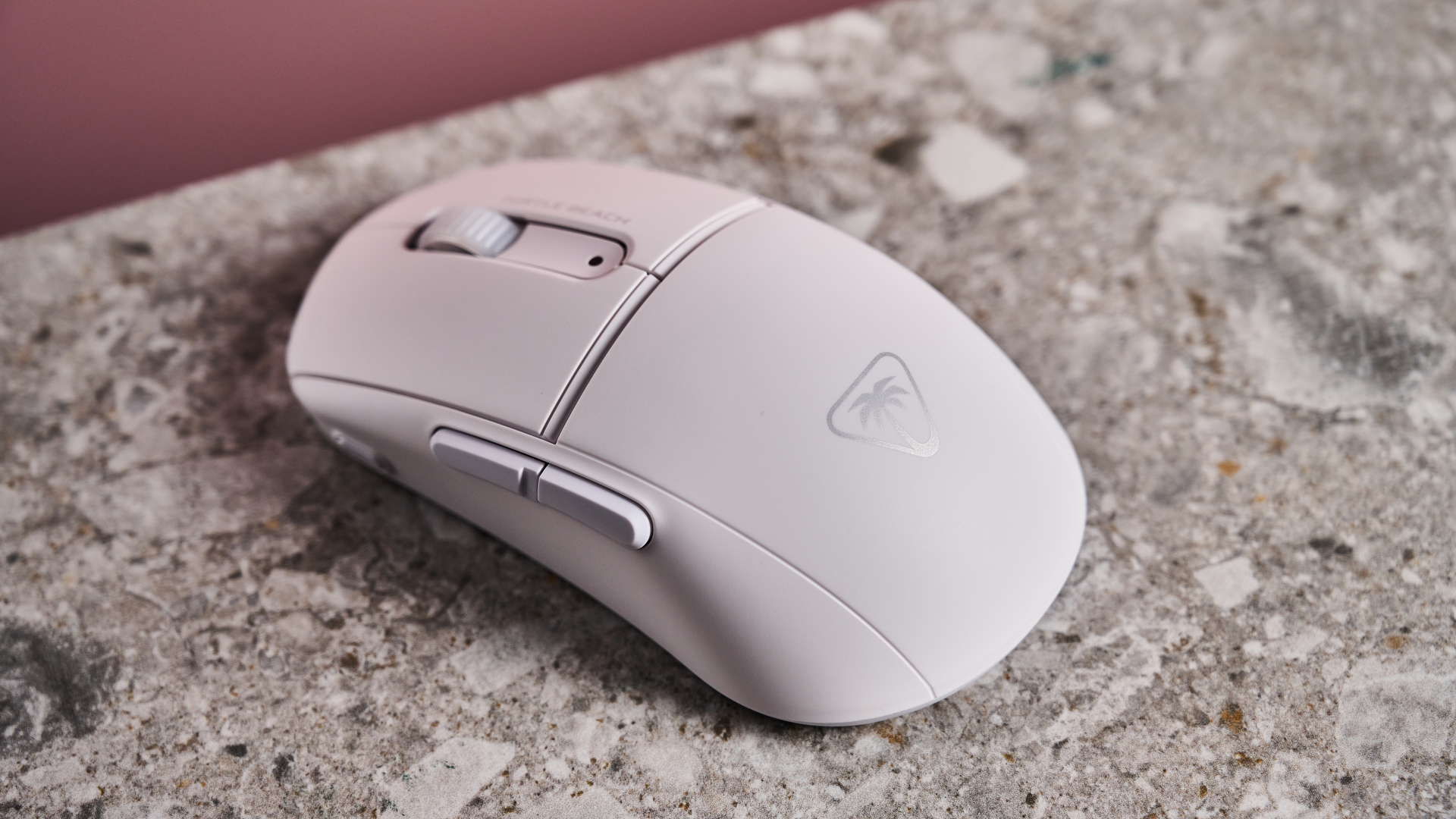Turtle Beach Burst 2 Air review: a gaming mouse that’s light on weight, but not on price
Turtle Beach Burst 2 Air: Two-minute review
The Turtle Beach Burst 2 Air is the brand’s new ultralight gaming mouse promising top-tier performance, which it hopes to achieve with its ergonomic design, quality hardware, and in-depth tweakability.
Considering the Burst 2 Air is a full-size gaming mouse, it’s remarkable that it only tips the scales at 47g, undercutting many gaming mice in the lightweight category. Rather than sporting an all-over honeycomb design to shed the weight, it has just two small cutouts underneath that expose the underside to the PCB within. Despite this absence of material, Turtle Beach has managed to include a handy slot to store the 2.4GHz USB receiver. As an exercise in cutting weight, it’s impressive.
With its understated appearance, the Burst 2 Air cuts a rather unremarkable figure, especially compared to the audacious looks of some of the best gaming mice. The white colorway I tested does look more vibrant than its black counterpart, and the light gray accents on the logo, side buttons, and scroll wheel are a nice touch. There are two small LEDs, one between the mouse buttons and another under the scroll wheel, but these are relatively subtle. The finish is smooth with a slight texture that I found suitable for my palm and fingers, although grip tape is included in the box for those who prefer something more substantial.
The Burst 2 Air fits nicely in the hand, with an even curve all around, although there’s slightly more bulk towards the back end. There isn’t much of a forward rake either, so it doesn’t feel like your fingers are falling away. Turtle Beach doesn’t recommend specific grip styles but it seems ideal for most, though it may be too bulky for those who prefer the claw type. My only real complaint about the shape of the Burst 2 Air is that the sides cinch inwards a little too much for my liking, making it harder to squeeze during those clutch moments.
The mouse wheel is softly notched but still provides enough security to prevent mis-scrolls. It’s tight and secure when pressed, while still being easy to actuate. The side buttons are very clicky, and their angle and protrusion make them easy to use. Rather than being situated on top or underneath, as is typical for many gaming mice, the DPI cycle button is located on the left front side. It’s small and pressing it can be awkward, given it’s quite close to the bottom, meaning your thumb ends up pressing into your desktop. This is a small grievance, though, and the button operates smoothly.

When it comes to the business of gaming, the Burst 2 Air is a joy to use. Maneuverability is exceptional, gliding effortlessly on almost any surface, thanks to the thick PTFE skates. The pre-tensioned optical switches can be activated with light clicks, and although they travel further than I expected, this only adds to their satisfaction. There is the slightest indentation on the buttons themselves, just enough to guide your fingers to the optimal position.
Coupled with the ultra-light total weight, this makes the Burst 2 Air very precise. Of course, what weight, shape, and size is best for a gaming mouse comes down to personal preference, but for me, I found the Burst 2 Air ideal for my hands and swipes. Using it with the included USB cable does add more resistance to movements, but I adapted to it quickly, and I wouldn’t go so far as to call it drag, with all the negative connotations that word brings. As with many braided cables, durability can be an issue, but during my time using it I didn’t notice any fraying.
For customizing and adjusting settings, you’ll need Swarm 2, Turtle Beach’s peripheral software. As soon as you open it, you’re greeted with jagged fonts that are hard to read and fail to inspire much confidence. I have previous experience using this software with a Turtle Beach keyboard, and in that case, I found it to be obtuse in places and not the most user-friendly. Some of my concerns remain in place in the case of the Burst 2 Air, although I do think mice settings are more clearly laid out.
The software allows for all the typical tweaks you'd expect, including adjustments for the DPI. However, this has a clunky implementation, requiring you to drag dots across the screen for each of the five predefined settings. In theory, this interface is a good idea, but it’s poorly executed here, with bugs and glitches occurring until I updated the mouse’s firmware. The update also fixed the battery level readout, which was previously stuck at 18%, even when charging.
There are also adjustments for the poll rate, with five settings ranging from 125Hz to 1000Hz, and a debounce time slider in a nondescript unit between 0 and 10 (a lot of other software I’ve tested measure this in milliseconds). There’s also DCU calibration, which is equivalent to lift-off distance. There are two predefined settings, very low and low, as well as a custom mode that automatically sets the distance based on a few test movements. Again, though, there is no indication in any setting as to what the exact distance you’ve set is.

Other settings include angle snapping, which smooths cursor movements by making them more linear, and motion sync, which aligns the mouse’s polling rate to that of your PC, so only the latest polling data is read. In theory, this improves accuracy as tracking becomes more seamless, but in reality, only hardcore pro players will likely notice or care about this. During my tests, I failed to notice much difference when activated.
It’s also compatible with Nvidia Reflex, which claims to reduce input latency even further when gaming. It requires an Nvidia GPU and a monitor compatible with Nvidia G-Sync (although my FreeSync monitor worked with this too). It’s only currently supported by a handful of games, and again it’s a feature that only pro players will likely notice in action.
Switching between the different connectivity modes worked fairly seamlessly in my experience, letting me switch between two devices on the fly with a flick of the switch underneath. Note, however, that when connected via USB cable, this overrides your other connectivity options, so device switching effectively becomes unavailable until you pull the plug.
The claimed battery life of the Burst 2 Air is 120 hours in Bluetooth mode, and 40 when using the 2.4GHz receiver. According to my tests, this seems accurate, as the battery barely dipped below 90% over several days of use, even when set to the maximum 1k poll rate.
The Burst 2 Air is a solid wireless gaming mouse for those who are after a comfortable yet speedy performer. The overall shape, low package weight, connectivity options, and smooth glides are its standout aspects. However, Swarm 2 isn’t the most intuitive peripheral software to use, and the fact is there are better value gaming mice that match the Burst 2 Air for performance, such as the Cooler Master MM311. It’s by no means a bad pointer to plump for, but there are plenty of other great options around for less money.
Turtle Beach Burst 2 Air: Price & availability

- $99 / £99 (about AU$147)
- Black and White colorways
The Burst 2 Air is priced at $99 / £99 (about AU$147) and is available now. It comes in either Black or White colorways.
For a gaming mouse of this spec, the Burst 2 Air represents pretty average value for money. It competes with other wireless mice such as the Razer DeathAdder V3 Hyperspeed, which offers similar features and functionality. It also supports an 8k poll rate, although this does require Razer’s HyperPolling Wireless Dongle, which costs an extra $29 / £29 / AU$54.
If you’re after a wireless gaming mouse with an 8k poll rate straight out of the box, then be prepared to part with more cash. Offerings in this category can set you back considerably more: the Razer Viper V3 Pro, for example, is over $100 / £150 / AU$275.
However, if you’re happy with 1k, there are more wireless budget picks than ever. For instance, there’s the Cooler Master MM311, which is our current pick as the best gaming mouse for those on a budget – it’s heavier than the Burst 2 Air and runs on AA batteries, though. If you want a rechargeable battery, then the HyperX Pulsefire Haste 2 could fit the bill; although it weighs 61g, it’s slightly cheaper than the Burst 2 Air. There’s also a wired variant with an 8k poll rate for even less.
Turtle Beach Burst 2 Air: Specs
Should you buy the Turtle Beach Burst 2 Air?
Buy it if...
You want a super-light mouse
49g is seriously light, making the Burst 2 Air ideal for rapid movements. It’s even more impressive considering the body is full-size.
You want a smooth glider
The Burst 2 Air glides with incredible ease, thanks to the thick PTFE skates, working well on different surface types.
You want multiple connectivity options
The Burst 2 Air can be connected using the included USB-C to USB-A PhatomFlex cable, or wirelessly via the 2.4GHz USB receiver or Bluetooth, which allows for quick-switching between devices.
Don't buy it if...
You want a high poll rate
Gaming mice that are marketed for esports use usually offer poll rates up to 8k, but the Burst 2 Air tops out at 1k. If this matters to you, then look elsewhere.
You’re on a budget
The Burst 2 Air is averagely priced for a gaming mouse of this spec. There are more budget-friendly wireless gaming mice available than ever, so you’ll likely be able to find cheaper alternatives with similar levels of performance.
Turtle Beach Burst 2 Air: Also consider
How I tested the Turtle Beach Burst 2 Air
- Tested for two weeks
- Played FPS and strategy games
- 10+ years PC gaming experience
I tested the Burst 2 Air for around two weeks. During that time, I used it with a variety of games, as well as for general use and productivity.
I played FPS titles including Counter-Strike 2, the evergreen peripheral tester, as well as strategy games that almost exclusively use mouse inputs, such as Tactical Breach Wizards.
I have been PC gaming for over a decade, and during that time I have tried a variety of gaming mice of all shapes and sizes from the likes of Razer, Logitech, Alienware, and HyperX, to name a few. I generally prefer full-size mice over miniature ones and prefer a light to medium weight.
First reviewed: September 2024
0 comments:
Post a Comment